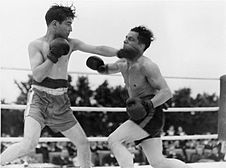Introduction
Boxing is a combat sport in which two people engage in a contest of strength, speed, reflexes, endurance, and will, by throwing punches at each other, usually with gloved hands. Historically, the goals have been to weaken and knock down the opponent.
Task
- You cannot hit below the belt, hold, trip, kick, headbutt, wrestle, bite, spit on, or push your opponent.
- You cannot hit with your head, shoulder, forearm, or elbow.
- You cannot hit with an open glove, the inside of the glove, the wrist, the backhand, or the side of the hand.
- You cannot punch your opponent's back, or the back of his head or neck (rabbit punch), or on the kidneys (kidney punch).
- You cannot throw a punch while holding on to the ropes to gain leverage.
- You can't hold your opponent and hit him at the same time, or duck so low that your head is below your opponent's belt line.
- When the referee breaks you from a clinch, you have to take a full step back; you cannot immediately hit your opponent--that's called "hitting on the break" and is illegal.
- You cannot spit out your mouthpiece on purpose to get a rest.
- If you score a knockdown of your opponent, you must go to the farthest neutral corner while the referee makes the count.
- If you "floor" your opponent, you cannot hit him when he's on the canvas.
- A floored boxer has up to ten seconds to get back up on his feet before losing the bout by knockout.
- A boxer who is knocked down cannot be saved by the bell in any round, depending upon the local jurisdiction's rules.
- A boxer who is hit with an accidental low blow has up to five minutes to recover. If s/he cannot continue after five minutes, s/he is considered knocked out.
- If the foul results in an injury that causes the fight to end immediately, the boxer who committed the foul is disqualified.
- If the foul causes an injury but the bout continues, the referee orders the judges to deduct two points from the boxer who caused the injury.
- If an unintentional foul causes the bout to be stopped immediately, the bout is ruled a "no contest" if four rounds have not been fully completed. (If the bout was scheduled for four rounds, then three rounds must have been completed.) If four rounds have been completed, the judges' scorecards are tallied and the fighter who is ahead on points is awarded a technical decision. If the scores are even, it will be called a "technical draw."
- If a boxer is knocked out of the ring, he gets a count of 20 to get back in and on his feet. He cannot be assisted.
- In some jurisdictions the standing eight-count or the three knockdown rule also may be in effect.
- In other jurisdictions, only the referee can stop the bout.
Process
Boxing is a combat sport in which two people engage in a contest of strength, speed, reflexes, endurance, and will, by throwing punches at each other, usually with gloved hands. Historically, the goals have been to weaken and knock down the opponent.
Evaluation
Since boxing involves forceful, repetitive punching, precautions must be taken to prevent damage to bones in the hand. Most trainers do not allow boxers to train and spar without wrist wraps and boxing gloves. Hand wraps are used to secure the bones in the hand, and the gloves are used to protect the hands from blunt injury, allowing boxers to throw punches with more force than if they did not utilize them. Gloves have been required in competition since the late nineteenth century, though modern boxing gloves are much heavier than those worn by early twentieth-century fighters. Prior to a bout, both boxers agree upon the weight of gloves to be used in the bout, with the understanding that lighter gloves allow heavy punchers to inflict more damage. The brand of gloves can also affect the impact of punches, so this too is usually stipulated before a bout.
A mouth guard is important to protect the teeth and gums from injury, and to cushion the jaw, resulting in a decreased chance of knockout. Both fighters must wear soft soled shoes to reduce the damage from accidental (or intentional) stepping on feet. While older boxing boots more commonly resembled those of a professional wrestler, modern boxing shoes and boots tend to be quite similar to their amateur wrestling counterparts.
Boxers practice their skills on two basic types of punching bags. A small, tear-drop-shaped "speed bag" is used to hone reflexes and repetitive punching skills, while a large cylindrical "heavy bag" filled with sand, a synthetic substitute, or water is used to practice power punching and body blows. In addition to these distinctive pieces of equipment, boxers also utilize sport-nonspecific training equipment to build strength, speed, agility, and stamina. Common training equipment includes free weights, rowing machines, jump rope, and medicine balls.
Boxing matches typically take place in a boxing ring, a raised platform surrounded by ropes attached to posts rising in each corner. The term "ring" has come to be used as a metaphor for many aspects of prize fighting in general.
Conclusion
I think it is a good sport
Credits
Divija Singh